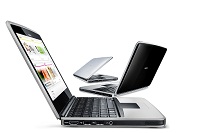Nokia Booklet 3G review
We review Nokia's Booklet 3G to see if it is more than just a netbook.

There’s no doubt that the Nokia Booklet 3G is attractive and well built. However, its feature set puts it at the low end of the netbook market, yet it carries a high-end price tag. Built-in 3G connectivity and a battery that genuinely will last for a working day set it out from the crowd, but in return Nokia is asking for a price premium that would make even Apple blush. To work as a business device, the Booklet 3G needs to be faster, cheaper or - ideally - both.
Netbooks were one of the few types of PC whose market grew to any meaningful extent last year. But it still takes a brave manufacturer to enter that crowded market for the first time let alone a manufacturer that is launching its first Windows PC business. Launching a netbook that is twice the price of most competing units only adds to the risk.
But this is exactly what Nokia has done with the Booklet 3G, a stylish but pricy addition to the netbook class of computer. Nokia has not made PCs since the early 1990s, when it sold its Nokia Data division to ICL, and now can hardly be the most promising time to enter the volume computer market.
Nokia, though, has taken steps to make the Booklet 3G stand out from the crowd. Good connectivity, as would be expected from a mobile phone company, and a stylish case made partly from aluminium.
Then there is also the price: the Booklet 3G is available to pre-order from the Nokia store for 552 plus VAT (649 inc VAT). This is lower than the 799 (681 plus VAT) price being quoted by independent resellers such as Expansys who have stocks for immediate delivery, but still considerably more than almost all competing netbooks, and squarely in the price bracket of a lower mid-range business laptop.
Nokia, though, does not call the Booklet 3G a netbook, but insists instead on the term "mini computer". The question for business users is whether the performance, design and features of the Booklet 3G justify the price. In some respects they do, in others, the Booklet is lacking.
Features
The Booklet 3G is not lacking in features and it is pleasing on the eye too. The first feature that stands out, when unboxing the machine, is the smart aluminium casing. The blue cardboard packaging is pretty nice too, and fully recyclable as we've come to expect from Nokia. The computer is light, at 1.25kg, and on first impressions the Booklet looks very much like a slimmed-down 13in MacBook Pro.
Get the ITPro daily newsletter
Sign up today and you will receive a free copy of our Future Focus 2025 report - the leading guidance on AI, cybersecurity and other IT challenges as per 700+ senior executives
-
 Women show more team spirit when it comes to cybersecurity, yet they're still missing out on opportunities
Women show more team spirit when it comes to cybersecurity, yet they're still missing out on opportunitiesNews While they're more likely to believe that responsibility should be shared, women are less likely to get the necessary training
By Emma Woollacott Published
-
 OpenAI wants developers using its new GPT-4.1 models – but how do they compare to Claude and Gemini on coding tasks?
OpenAI wants developers using its new GPT-4.1 models – but how do they compare to Claude and Gemini on coding tasks?News OpenAI says its GPT-4.1 model family offers sizable improvements for coding, but tests show competitors still outperform it in key areas.
By Ross Kelly Published
-
 Meta just revived plans to train AI models with European user data – here’s how you can opt out
Meta just revived plans to train AI models with European user data – here’s how you can opt outNews Meta has confirmed plans to train AI models using European users’ public content and conversations with its Meta AI chatbot.
By Nicole Kobie Published